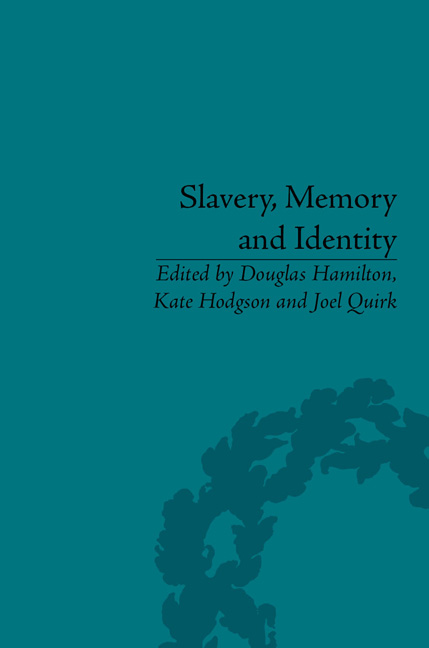Book contents
- Frontmatter
- CONTENTS
- Acknowledgements
- List of Contributors
- Introduction: Slavery, Memory and Identity: National Representations and Global Legacies
- 1 ‘A Thoroughly National Work’: The Politics of Blame and European Abolitionist Identities
- 2 From Slave Quarters to Wigwams: Native American Slaveholding and the Debate over Civilization
- 3 For Civilization's Sake: Legal Abolition of Slavery in Nepal and Sierra Leone in a Global Perspective, 1920–30
- 4 The Heritage of Slavery and Nation Building: A Comparison of South Africa and Mauritius
- 5 Picturing Slavery: The Perils and Promise of Representations of Slavery in the United States, the Bahamas and England
- 6 ‘History Must be Re-Written!’: Revisionist Ambitions among West African Slave Descendants
- 7 Contrapuntal Memories of Slavery and Abolition in the French-Speaking World
- 8 Public Memory of Slavery in Brazil
- 9 Learning to Remember and Imagine Slavery: The Pedagogies of Museum Field Trips in the Representation of ‘Difficult’ Histories
- 10 Slavery and Racism as the ‘Wrongs’ of (European) History: Reflections from a Study on Portuguese Textbooks
- Notes
- Index
Introduction: Slavery, Memory and Identity: National Representations and Global Legacies
- Frontmatter
- CONTENTS
- Acknowledgements
- List of Contributors
- Introduction: Slavery, Memory and Identity: National Representations and Global Legacies
- 1 ‘A Thoroughly National Work’: The Politics of Blame and European Abolitionist Identities
- 2 From Slave Quarters to Wigwams: Native American Slaveholding and the Debate over Civilization
- 3 For Civilization's Sake: Legal Abolition of Slavery in Nepal and Sierra Leone in a Global Perspective, 1920–30
- 4 The Heritage of Slavery and Nation Building: A Comparison of South Africa and Mauritius
- 5 Picturing Slavery: The Perils and Promise of Representations of Slavery in the United States, the Bahamas and England
- 6 ‘History Must be Re-Written!’: Revisionist Ambitions among West African Slave Descendants
- 7 Contrapuntal Memories of Slavery and Abolition in the French-Speaking World
- 8 Public Memory of Slavery in Brazil
- 9 Learning to Remember and Imagine Slavery: The Pedagogies of Museum Field Trips in the Representation of ‘Difficult’ Histories
- 10 Slavery and Racism as the ‘Wrongs’ of (European) History: Reflections from a Study on Portuguese Textbooks
- Notes
- Index
Summary
The contested nature of public memories of slavery, slave trades and their abolitions was made manifest at Westminster Abbey in London in March 2007. There, surrounded by the pomp of the British state and the shrines of British heroes, the British monarch, her ministers and an invited audience celebrated the bicentenary of the abolition of the British transatlantic slave trade. Some groups were incensed by the apparent ‘white-washing’ of Britain's slave past; the Westminster service was disrupted by a leading pan-African activist who proclaimed the event a ‘Wilberfarce’. Amidst much head-shaking and tut-tutting, he was forcibly ejected from the building.
Memories of British slavery and abolition thus varied widely; so, too, did the politicized contexts from which they sprang. Yet this is far from being a solely British phenomenon. Efforts to describe and delineate slavery to and by the public have never been objective or disinterested. Instead, they have been consistently animated by prevailing conceptions of national ‘honour’, understandings of ‘civilization’ and a sense of imagined citizenship and community. In the last case, national representations of slavery have often sought to minimize collective responsibility for enslavement, while emphasizing contributions to abolitionism. In the twenty-first century, these national perspectives continue to influence public representations of slavery across the globe, often through new forms of multiculturalism and manifestations of a shared historical ancestry and sense of collective identity.
The ten chapters that make up this volume speak to the modern fascination with slavery and try to suggest why it emerged with such force at the end of the twentieth century. They are particularly concerned with the way in which slavery and its legacies have found expression in the commemorative contexts of museums, memorials and other sites of memory, as well as in national education systems. They also show that although the political and temporal contexts may have changed, understandings of slave pasts (broadly defined) have always been intertwined with evolving forms of identity, belonging and community.
- Type
- Chapter
- Information
- Slavery, Memory and IdentityNational Representations and Global Legacies, pp. 1 - 14Publisher: Pickering & ChattoFirst published in: 2014

